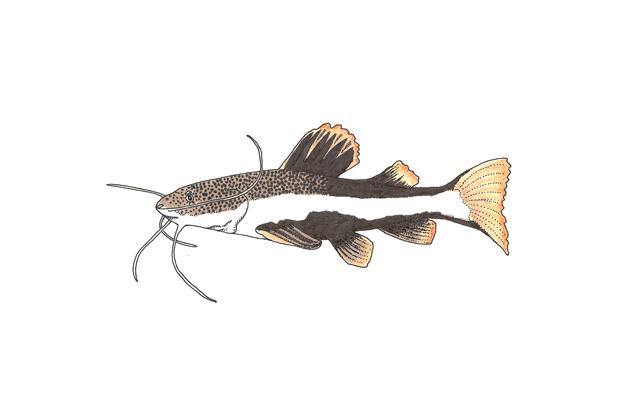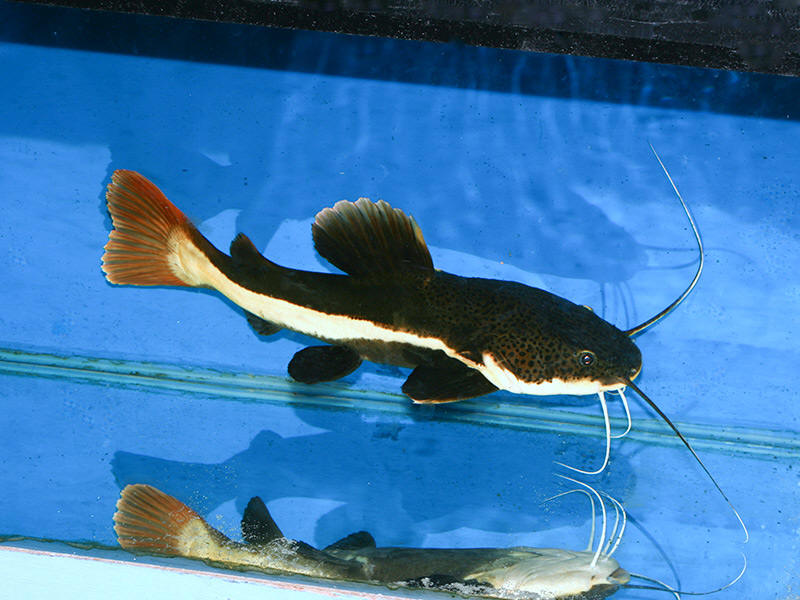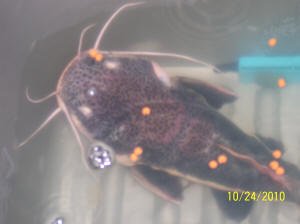Redtail catfish often suffer from parasitic infections and poor water quality. These issues can lead to stress and illness.
Redtail catfish, known scientifically as Phractocephalus hemioliopterus, are popular in the aquarium trade due to their striking appearance and large size. Despite their appeal, they require proper care to thrive. Parasitic infections are common health problems, often resulting from poor water conditions or stress.
Regular tank maintenance and monitoring water quality can prevent these issues. Overfeeding can also lead to obesity and related health problems. Providing a balanced diet and adequate space is crucial for their well-being. Ensuring a clean, stable environment and routine health checks can help keep your redtail catfish healthy and vibrant.
Introduction To Redtail Catfish
The Redtail Catfish, scientifically known as Phractocephalus hemioliopterus, is a popular freshwater fish. They are admired for their striking appearance and large size. Many aquarium enthusiasts love keeping them.
Physical Characteristics
The Redtail Catfish has a unique look. They have a dark body with a vibrant red tail. Their bodies are long and can grow up to 4 feet in captivity. They have whisker-like barbels around their mouths. These help them detect food in murky waters. Their fins are strong and help them swim swiftly.
| Feature | Description |
|---|---|
| Color | Dark body with a red tail |
| Length | Up to 4 feet |
| Barbels | Whisker-like structures around the mouth |
Natural Habitat
The Redtail Catfish is native to South America. They are found in the Amazon and Orinoco river basins. They thrive in warm, slow-moving waters. These waters are often murky and rich in nutrients. They use their barbels to find food in these conditions.
In the wild, they eat a variety of foods. Their diet includes fish, crustaceans, and insects. They are opportunistic feeders and eat whatever they can find. This makes them grow large and strong.
- Native to South America
- Found in Amazon and Orinoco river basins
- Thrive in warm, slow-moving waters

Credit: www.best4pets.in
Common Health Issues
Redtail Catfish are popular due to their striking appearance. Still, they face several health issues. Understanding these problems helps in maintaining their health.
Fungal Infections
Fungal infections often affect Redtail Catfish. They appear as white or gray patches on the skin. These patches can be fuzzy or cotton-like.
Fungal infections are usually caused by poor water quality. A weakened immune system also contributes. Symptoms include lethargy and loss of appetite.
To treat fungal infections, improve water conditions. Use anti-fungal medications. Regular water changes can prevent these infections.
Parasitic Infestations
Redtail Catfish are susceptible to parasitic infestations. Common parasites include ich, flukes, and anchor worms. These parasites cause significant stress.
Signs of parasitic infestations include scratching against surfaces. Fish may also exhibit rapid breathing. Visible spots or worms may appear on the skin.
Treat parasitic infestations with appropriate medications. Quarantine infected fish to prevent the spread. Ensure clean, well-maintained tanks.
| Health Issue | Symptoms | Treatment |
|---|---|---|
| Fungal Infections | White or gray patches, lethargy | Improve water quality, use anti-fungal meds |
| Parasitic Infestations | Scratching, rapid breathing, visible spots | Use appropriate meds, quarantine infected fish |
Nutritional Deficiencies
Redtail Catfish need a balanced diet to stay healthy. Without proper nutrition, they can suffer from various health issues. Nutritional deficiencies are common in these fish, leading to several problems. Understanding the signs and ensuring a proper diet is crucial.
Signs Of Malnutrition
Malnutrition in Redtail Catfish shows through various signs. Watch out for:
- Loss of Appetite: The fish may refuse to eat.
- Weight Loss: Noticeable thinning of the fish’s body.
- Color Fading: The vibrant colors may dull.
- Lethargy: Reduced activity and sluggish movements.
- Fin Damage: Frayed or damaged fins.
Proper Diet
Providing a balanced diet is essential for Redtail Catfish. Here are key components:
| Food Type | Description |
|---|---|
| High-Protein Pellets | Pellets with high protein content are ideal for growth. |
| Live Foods | Small fish, worms, and shrimp provide essential nutrients. |
| Frozen Foods | Frozen fish and shrimp are good alternatives to live food. |
| Vegetables | Occasional greens like peas and spinach aid digestion. |
Follow these tips for a proper diet:
- Feed a varied diet to cover all nutritional needs.
- Ensure the food size matches the fish’s mouth size.
- Avoid overfeeding to prevent water quality issues.
Water Quality Problems
Redtail Catfish are sensitive to water quality. Poor water can make them sick. Ensuring clean water is vital for their health. Let’s explore the key areas to focus on.
Ideal Water Parameters
Redtail Catfish need specific water conditions. Here are the ideal parameters:
| Parameter | Ideal Range |
|---|---|
| Temperature | 22-28°C (72-82°F) |
| pH Level | 6.0-7.5 |
| Ammonia | 0 ppm |
| Nitrite | 0 ppm |
| Nitrate | < 20 ppm |
Testing And Maintenance
Regular testing is crucial for Redtail Catfish health. Use a reliable water test kit. Test the water weekly to ensure it stays in the ideal range.
Steps for Water Testing:
- Collect a water sample from your tank.
- Use the test kit to check levels.
- Compare results with the ideal parameters.
If levels are off, take immediate action. Perform partial water changes to correct issues. Keep the tank clean to prevent future problems.
Regular Maintenance Tips:
- Change 25% of the water every week.
- Clean filters monthly.
- Remove uneaten food daily.
Healthy water ensures your Redtail Catfish thrive. Regular checks and maintenance are key to their well-being.
Behavioral Signs Of Illness
Understanding the behavioral signs of illness in redtail catfish is crucial. Recognizing these signs early can help in treating the fish promptly. Here, we explore some common behavioral changes that may indicate health issues.
Unusual Swimming Patterns
Redtail catfish usually swim smoothly and gracefully. If you notice erratic or unusual swimming patterns, this could be a sign of illness. Keep an eye out for:
- Swimming in circles
- Darting around the tank
- Floating upside down or sideways
These behaviors may indicate problems like infections or swim bladder disease.
Lethargy And Appetite Loss
A healthy redtail catfish is active and has a good appetite. If your fish becomes lethargic or loses interest in food, it could be ill. Look for the following signs:
- Spending more time at the bottom of the tank
- Not responding to food
- Slow or minimal movement
Lethargy and appetite loss can be symptoms of various health problems, including parasites or poor water quality.
| Behavioral Sign | Possible Health Issue |
|---|---|
| Unusual Swimming Patterns | Infections, Swim Bladder Disease |
| Lethargy | Parasites, Poor Water Quality |
| Appetite Loss | Parasites, Infections |
Monitoring these behavioral signs closely can help you keep your redtail catfish healthy.

Credit: m.espacepourlavie.ca
Preventative Measures
Preventing health problems in Redtail Catfish is crucial for their well-being. Implementing the right measures can keep them healthy and vibrant. Focus on quarantine, regular checkups, and good practices to maintain their health.
Quarantine New Fish
Always quarantine new fish before adding them to the main tank. New fish might carry diseases that can infect your existing fish. A separate tank for quarantine helps prevent the spread of illness.
Keep the new fish in quarantine for at least two weeks. Observe them for any signs of disease. Look for symptoms like:
- White spots
- Fin rot
- Unusual swimming patterns
If you notice any signs, treat the fish accordingly. Only introduce healthy fish to your main tank.
Regular Health Checkups
Conduct regular health checkups for your Redtail Catfish. Routine checks help spot early signs of disease. Early detection makes treatment easier and more effective.
Make a habit of monitoring their health weekly. Keeping a health log can be useful. Record any changes or concerns you observe.
Regular checkups ensure your fish stay healthy and active. A little effort goes a long way in preventing health problems.
| Preventative Measure | Benefit |
|---|---|
| Quarantine New Fish | Prevents spread of disease |
| Regular Health Checkups | Early detection of health issues |
Treatment Options
Redtail catfish are popular in home aquariums. They are prone to health issues. Proper treatment options are essential for their well-being. This section explores effective treatments.
Medications And Remedies
Various medications and remedies can treat redtail catfish. These include:
- Antibiotics: Treat bacterial infections.
- Antifungals: Combat fungal diseases.
- Parasiticides: Eliminate parasites.
Always dose medications correctly. Follow instructions on the packaging. Overdosing can harm your fish.
| Medication Type | Common Use | Dosage |
|---|---|---|
| Antibiotics | Bacterial Infections | As per instructions |
| Antifungals | Fungal Diseases | As per instructions |
| Parasiticides | Parasites | As per instructions |
Professional Veterinary Care
Professional veterinary care is crucial for serious health problems. A vet can:
- Diagnose the exact issue.
- Recommend specific treatments.
- Monitor recovery progress.
Seek a vet specializing in fish. They have the right expertise. Regular check-ups prevent many health issues.
Early intervention is key. This ensures a healthy, happy redtail catfish.

Credit: injaf.org
Frequently Asked Questions
What Is The Lifespan Of A Red Tail Catfish?
Red tail catfish typically live 15 to 20 years in captivity. Proper care and a suitable environment are essential.
Why Is My Red Tail Catfish Breathing Heavy?
Your red tail catfish might be breathing heavily due to poor water quality, stress, or disease. Check water parameters and ensure proper oxygenation.
How Often Should I Feed Red Tail Catfish?
Feed red tail catfish every other day. Provide a balanced diet with a mix of live, frozen, and pellet foods. Avoid overfeeding.
Do Red Tail Catfish Need Oxygen?
Yes, red tail catfish need oxygen. Ensure proper aeration with air pumps or filters to keep them healthy.
Conclusion
Proper care is essential to prevent Redtail Catfish health problems. Regular monitoring and a balanced diet can ensure their well-being. Maintain clean water conditions and provide adequate space. Address health issues promptly to keep your Redtail Catfish thriving. By following these steps, you can enjoy a healthy and vibrant pet.
